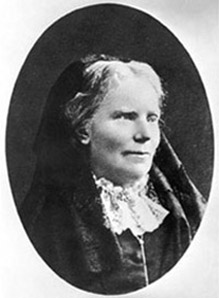| Featured Women | |||||
| Women at Queen Mary Online: a virtual exhibition | |||||
 |
|||||
| In this section: | Elizabeth Blackwell, Barts alumna | ||||
|
See also: > Women in Medicine and Dentistry > Women in Science and Engineering > Women in Arts and Humanities
|
|||||
Elizabeth Blackwell (1821-1910), was admitted to train at St Bartholomew's Hospital Medical College under Dr James Paget in 1850. She became the first qualified woman doctor to be listed on the Medical Register in 1859. She was born in Bristol, but emigrated with her family to America in 1831, later becoming a naturalised American citizen. She spent many years in Europe and Britain throughout her life, including her time training and working in London. When Blackwell's father died in 1838, her family was left with financial difficulties, and she with her elder sisters set up a school in order to support the family. In 1842, Blackwell became the head of a school for girls in Kentucky, though she did not stay there long due to her objections to slavery, which was still prevalent in the American south at that time. During the mid-1840s she continued working as a teacher, and also realised that her true ambition was to become a doctor. Her ambition was based on several issues, but mainly arose from the experience of a friend who, for reasons of modesty, was apprehensive to consult a male doctor. This resulted in her friend's uterine cancer reaching advanced stages due to receiving no treatment. Blackwell's journey to formally study medicine was not easy. It was suggested to her that she might find a way to study in Paris if she were willing to dress as a man, but she considered this to be immoral. She proceeded to engage in independent study, whilst she applied to medical schools and received rejections from all of them. Finally, in 1847, a small medical school at Geneva in New York State accepted her as a student. She was the only woman student, and though her male colleagues did not take her very seriously, she graduated in 1849 at the top of her year, above all 150 of the male students. Blackwell went on to pursue further medical training in Europe, enrolling in 1849 at La Maternité in Paris. During her time in Paris, she contracted an eye infection, which left her blind in one eye and partially-sighted in the other. Although her aim of become a surgeon were dashed by this, she was still committed to pursue her medical career. In 1850, she was admitted to train as a doctor at St Bartholomew's Hospital Medical College, and was given access to all departments, except, ironically, the one for women. Following her training at Barts and several years working in New York , London and elsewhere, she became the first woman doctor to be listed on the Medical Register in 1859.
Blackwell was an advocate of medical care for women by women, and she actively promoted medical education for women throughout her life. She wrote many lectures on health issues relating to women, and in 1852 she published The Laws of Life; with Special Reference to the Physical Education of Girls. In 1858, she embarked on a year-long lecture tour addressing topics including the value of physiological and medical knowledge to women. She was connected to other remarkable women of her time, including Florence Nightingale, with whom she visited a German hospital to explore medical provision abroad. Blackwell helped to found the London School of Medicine for Women with several other pioneering women doctors, including her sister, Emily Blackwell, Elizabeth Garrett Anderson and Sophia Jex-Blake. In 1875, Blackwell became Professor of Gynaecology at the London School of Medicine for Women, and retired in 1907. She died in 1910 in Hastings , where she lived toward the end of her life. |
| << previous | Explore Featured Women |
|


